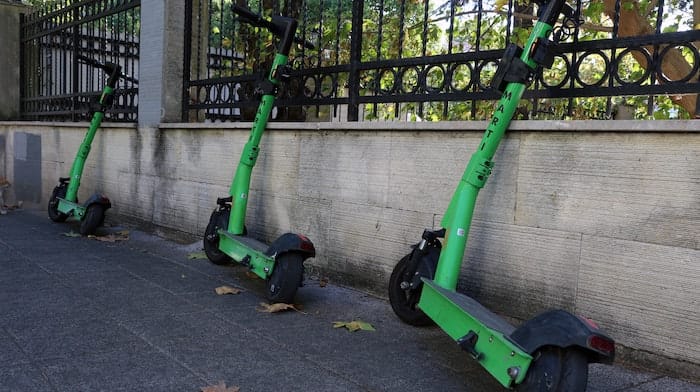Future magic circle trainee Will Holmes looks at the case for greater regulation

In 1915, the Autoped Company of America launched what the stunned cycling industry could only describe as a “freak vehicle”. First conceptually devised almost 100 years earlier by Baron Karl von Drais, they were referring to the forefather of today’s e-scooter. According to the Online Bike Museum, it was “essentially an enlarged child’s scooter with an engine mounted over the front wheel” that could travel at 20 mph (or apparently 35mph when pushed!).
In an America where urban traffic regulations were nascent (traffic lights were only installed in Cleveland in 1914 and in New York in 1918) and dangerous driving was rife, the e-scooter became a favourite amongst “groups of rowdy youths”. Although the scooters were eventually able to overcome the high price tags that had been a barrier to entry in the 1920s, new regulations eventually killed off the commercial viability of the product.
Their target market — those who generally had either little concern for or an inability (by virtue of their age) to comply with regulations in their pursuit of a cheap and easy method of transport — was wiped out by more burdensome compliance requirements (such as requiring users to have insurance and a driver’s licence). The motorised scooter industry had not anticipated the lethal potential of being treated like any other motorised vehicle by the law.
But almost a century since its explosion into the Wild West of developing traffic regulation, the scooter has returned under the fun and eco-friendly guise of the e-scooter. This has seen the e-scooter hit a wider audience and assert a stronger position amongst commuters than their motorised predecessors. The question now is how will the UK government approach the regulation of e-scooters? With government trials of e-scooters having been extended until 31 March 2022, there appear to be two key areas for consideration.
The first is whether to restrict access to e-scooters to certain rental operators or to allow private ownership. Limiting the use of e-scooters to rental providers such as Lime, Voi and Bolt (amongst others) has the advantage of increased control and accountability. Governments can regularly review the number of e-scooters these companies are allowed to operate and impose new restrictions which can be implemented with immediate effect. A good example of where this has happened has been in Scandinavia which is now leading the way with e-scooter regulations.
Since 2018, the cities of Oslo, Stockholm and Copenhagen have all seen a rapid rise in the number of e-scooter operators using this ‘free floating’ model, where e-scooters can be picked up and dropped off anywhere in the city. In 2021, there were 200 e-scooters per 10,000 residents in Oslo — the highest concentration per capita in the world. This untamed growth that is vital in order not to be swallowed up by their bottom line led to a “jungle” of inconveniently parked scooters and a host of headline-grabbing and hospital-burdening injuries.
Now these operators have felt the full force of effective regulatory whiplash. In July 2021, Oslo capped the number of e-scooters at 8,000. In October 2020, Copenhagen banned 13 e-scooter operators altogether, only readmitting a handful a year later on tougher terms including parking restrictions and off-limits zones. These measures would not have been nearly as effective in a location where e-scooters are predominantly privately owned.
Want to write for the Legal Cheek Journal?
Find out moreThe second key issue for consideration is whether the law should treat e-scooters like a bicycle or motor vehicle. Ever since the bike (specifically the Penny Farthing) shed its reputation as a dangerous method of travel in the 19th century, the pedal-bicycle’s popularity and alignment with policy objectives has led to little regulation for cyclists. Unlike for motorised vehicles, you do not need a licence or insurance to ride a bike.
Interestingly, electric bikes (a close cousin to the e-scooter) have been treated more like a bicycle than a motorised vehicle. Electrically assisted pedal cycles (EAPC) are classed as normal pedal bikes provided they cannot travel at more than 15.5mph. Yet for the purposes of the UK’s current trials, e-scooters are considered motorised vehicles.
Whether the same logic behind e-bikes’ classification will be applied to e-scooters largely depends on public sentiment. Will the growing list of e-scooter accidents and deaths sway the tide in favour of more stringent regulation? The UK has already had its fair share of e-scooter tragedies from YouTuber Emily Hartidge’s death as the first recorded fatality to a three-year old girl left with life-changing injuries after a collision in July.
Whatever the direction of these debates, one cannot ignore the issues around insurance. Given their current status as motorised vehicles, those injured by an e-scooter have a distinct advantage over those injured by an e-bike: the Motor Insurers’ Bureau (MIB) will compensate successful claimants for injuries caused at the hands of an uninsured e-scooter rider. This is not the case for EAPCs where insurance is not compulsory.
Going down the same route as e-bikes therefore might not be wise given the popularity of e-scooters amongst those who are unlikely to have insurance. Moreover, since unregistered e-scooters lend themselves to hit-and-run cases, the absence of the MIB, who investigate such claims for free, adds to concerns that victims will be left vulnerable.
And yet further peril may await! The UK government is planning to overturn a Court of Justice of the European Union ruling Damijan Vnuk v Zavarovalnica Triglav d.d. (that was confirmed by the Court of Appeal in MIB v Lewis) which in effect forces the MIB to compensate victims of uninsured motor accidents that occurred on private land. This gap would leave a portion of victims (namely those injured on private land) in the same uncertain position as victims of uninsured e-bike accidents.
Despite the strengths of the case for regulation, we must remember what happened to the scooter in the 1930s. If it is committed to a revival of the e-scooter, the government will have to astutely judge the manner and form of new regulation with the hope that it will not kill the e-scooter again.
Will Holmes is a future trainee solicitor at a magic circle law firm.



Please bear in mind that the authors of many Legal Cheek Journal pieces are at the beginning of their career. We'd be grateful if you could keep your comments constructive.